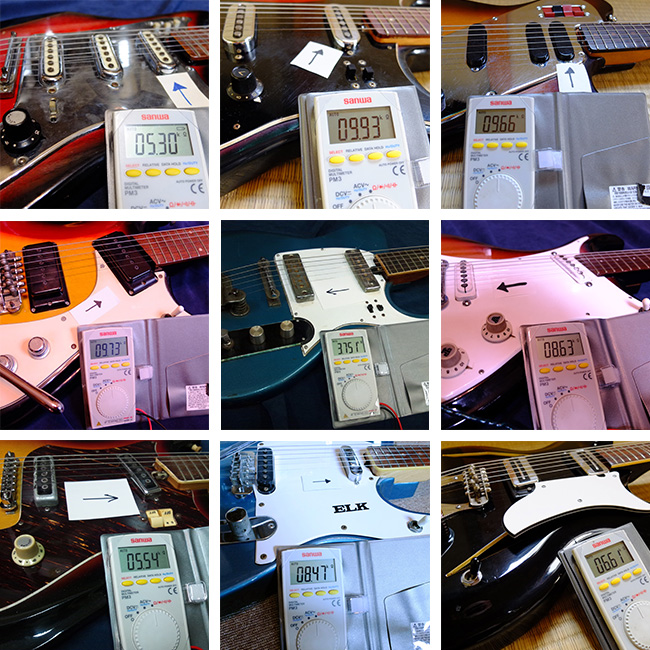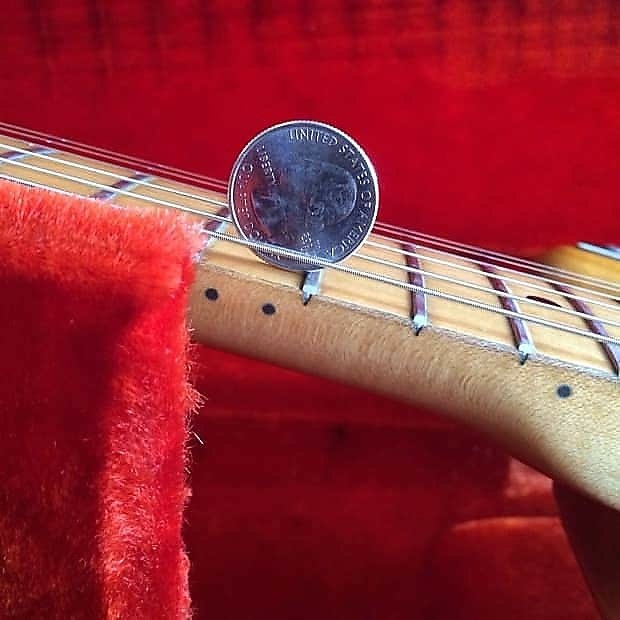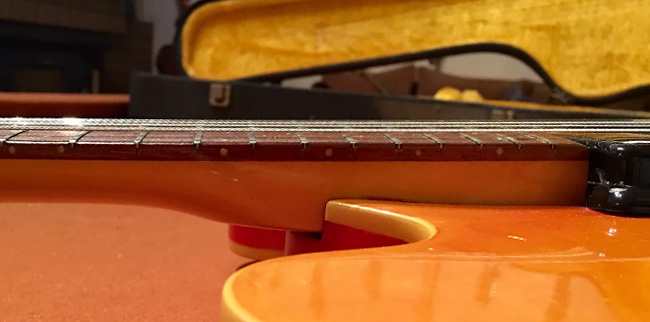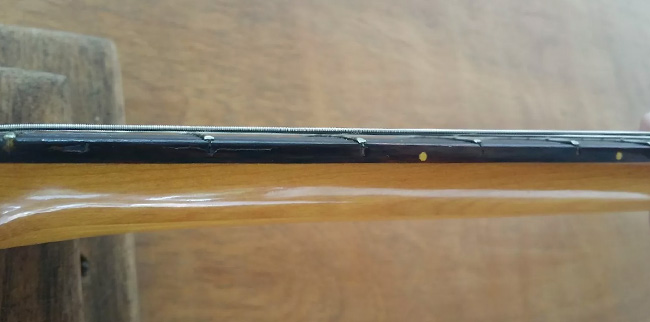In the 1960s, Japanese manufacturers flooded the market with truly unique guitar designs. Manufacturers like Teisco, Kawai, Guyatone, Fujigen, Matsumoku, Zen-On, and Shinko Gakki brought guitars to America sporting brand names like Kent, Silvertone, St. George, Conrad, Lafayette, Domino, and Kingston among many others.
For some, these guitars represent a cherished piece of childhood nostalgia and live on as fun guitars for rocking in the garage. Others just like the look of these guitars hanging on the wall.
But what do you need to look for before buying a made-in-Japan guitar from the '60s? From a pure playability standpoint, there are a few factors you should take into account resulting from the guitar's age and common manufacturing processes in Japan at the time.
Vintage Japanese Pickups

Just about all vintage ‘60s Japanese pickups are single coils. Even ones that look like humbuckers are generally just single coils inside a humbucker–like cover.
There are two things you want to look for: do the pickups have enough oomph to make the guitar worthwhile and are the pickups microphonic?
Pickup Output
A pickup’s output can be measured in oomph (that’s a technical term). DC resistance of the coil has become a sort of shorthand for a pickup’s output, but the two aren't always correlated. Coils with more resistance tend to have a “hotter” sound and drive your signal harder.
Magnet strength, coil inductance, and bobbin geometry also play a large part, but DC resistance is the thing generally measured by people looking at pickups. It also lets you know if the coil is damaged or not.
A good starting point is to try and look for guitars that have coils in the 5kΩ region or more which is generally in the territory of the pickup resistance on a ‘57 Strat. In the early ‘60s, Japanese pickups generally didn’t have a lot of oomph, often measuring in the 3k to 4kΩ region.
As the decade went on, the coils got bigger and started to pack more oomph. Some of the later ‘60s Japanese pickups get up into the 9 to 10kΩ region and pack plenty of punch.
Many sellers won’t know how to measure this, so you may have to rely on a subjective value. Look around on the internet. Chances are someone at some point has measured those pickups on a different guitar and that can give you a rough idea of what to expect.

Middle row: c1966 Morales Mosrite Clone, c1967 Domino Telecaster, c1967 Guyatone LG150
Bottom row: c1967 Kawai Silvertone Mosrite Style, c1968 Elk Cutlass, c1968 Firstman Tempter
Additionally, the YouTube channel Drowning in Guitars is a great resource for hearing how a lot of these pickups from vintage Japanese guitars sound.
Microphonic Pickups
Microphony occurs when the coil moves in response to physical vibrations affecting the guitar, rather than the strings disruption of the magnetic field of the pickups. This is caused by the coil becoming loose, or the potting insulation of the coil breaking down over time.
When a pickup is microphonic, you can tap on the pickguard and hear it through the amp. If you have microphonic pickups, playing through an amp at high volume will rattle the pickguard, pickup covers, and ultimately the coils, resulting in feedback.
A little bit of microphony can add some charm and unique character to a pickup, but too much of it can result in shrieking feedback, which has pretty limited applications.
Microphonic pickups can be cured by wax potting the pickups. It’s not a difficult process, but it’s one best left to professionals, as it requires a little bit of experience to do right and consistently.
Neck Profile and Fingerboard Radius
The “baseball bat” neck is an infamous nightmare for a lot of guitar buyers, though this actually appears to be more common among the more low budget exported instruments sent to the US market. The domestic guitars in Japan tend to have slimmer neck profiles. One theory behind this disparity is that guitar manufacturers simply thought Americans had bigger hands and would prefer the larger neck profiles.
Either way, the baseball bat necks are not as prevalent as you would first think and really only appear on guitars from the earlier part of the decade. A vast majority of vintage Japanese guitars from the ‘60s feature a 7.25” radius neck. The ones that don’t fall into this category are usually archtops from early in the decade with almost flat fingerboards.
While Teisco and Kawai produced some of the thickest profile necks around, all manufacturers slimmed down toward the end of the ‘60s. Some brands with reliably playable necks from this era are Elk, Morales, Pleasant, and Yamaha. Also, just about anything manufactured by the Matsumoku plant will have a comfortable neck
Action on Vintage Japanese Guitars
Unless you’re going looking to set up a vintage guitar for slide à la Ry Cooder, you’re going to want something that’s generally playable and even in good enough shape to be set up for regular use. Make sure the seller documents and describes the string height across the fretboard.

If the listing doesn’t include this, shoot them a message and ask them to photograph the string height using a quarter or other coin as context. Checking the height at the 5th and 12th frets is a good litmus test.
If the action looks high, it could be symptomatic of a deeper problem. Here’s what you should ask:
- Do you intentionally keep the action that high?
- Are the bridge saddles as low as they can go?
- When was the last time you adjusted the truss rod? Is it stripped?
If the bridge cannot be lowered any more and the person has no answer for the truss rod or says it’s adjusted as far as it can go, I would walk away from that particular specimen and wait for another to come along.
Fret Condition on Vintage Japanese Guitars
Japanese guitars from the ‘60s will often need new frets. Some of the manufacturers were using fretwire on guitars that was more suitable for mandolins.
If you’re totally in love with a specific model but the one you found has worn frets, don’t be afraid to negotiate the price so you have some money left over for a refret. Don’t let the need for a refret be a deal–breaker. Worn frets are going to be the rule rather than the exception on all guitars of this age.


A good refret can turn a bad instrument into a happily playable one.
Common Wear on the Bridge and Vintage Japanese Nuts
There are all kinds of bridges on vintage Japanese guitars. Some good, some bad. Bridges that can have the intonation adjusted usually won’t need replacing, but there are a lot of vintage Japanese guitars that have molded plastic bridges or single bar bridges that will have a limited amount of intonation.
When you find one of these guitars, you will likely want to budget for a replacement bridge. Replacing will sometimes be problematic due to the various post spacings used by the different manufacturers. Adapting a replacement bridge might take some creativity, but it is very doable.
You will find though that the most common replacement bridge—the Tune–o–matic—isn’t generally a good fit for vintage Japanese guitars because it doesn’t work so well with a tight 7.25” radius neck.
A good replacement bridge can still be held back by a poorly crafted nut. Many of the nuts on Japanese imports from the ‘60s were plastic (which wear down easily) and imprecisely cut. So a nut replacement usually goes hand in hand with replacing the bridge.
It’s a good move even if the bridge doesn’t need replacement. There are plenty of replacement nut options for the price of a Miller Lite 12-pack that will make a noticeable difference.
Bonus tip: Remember everything on a vintage Japanese Guitar is going to be metric, so if you’re planning to swap out the potentiometers but want to keep using the guitar’s original knobs, go with the metric option.
Japanese Vintage Guitars